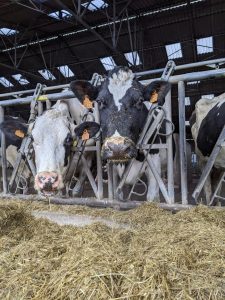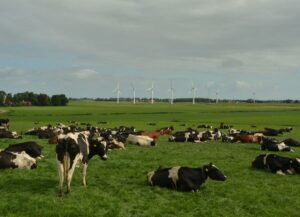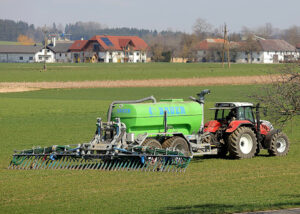Álvaro García
The 2025 butter market has surged, with spot prices reaching $2.56/lb. on June 5, the highest since January. Earlier lows of $2.24/lb. were driven by ample supplies, but growing demand has reversed that trend. Butter consumption in the U.S. hit a record of 200.1 million lbs. in April, up 23% from a year earlier. With domestic and global demand rising, butter stocks are tightening as the market heads into the high-consumption holiday season. Today’s market is evolving quickly, rewarding producers who align herd performance with rising component premiums. Reshaping genetics for higher butterfat seems like a smart, long-term strategy, particularly if your milk processor rewards components. Breeding cows for higher fat can boost profits, especially as consumer demand shifts toward natural fats. Here are key steps to succeed in a butterfat-focused market.
Evaluate your herd for component efficiency
Start by reviewing the average milk fat and protein percentages, the pounds of fat and protein produced per cow per day, and the Income Over Feed Cost by cow group. Cows that efficiently convert feed into butterfat are typically the most profitable in a component-based market. Conversely, cows with low component yields may be generating more cost than value, making them candidates for reevaluation or culling.
In this context, adequate performance is indicated by average fat percentages above 4.0% and protein above 3.2%, with daily yields of at least 3.0 pounds of fat and 2.4 pounds of protein per cow, depending on milk production. Keep in mind that breed differences matter, Jersey cows typically average 4.8% to 5.2% milk fat and 3.6% to 3.9% protein, while Holsteins range from 3.7% to 4.0% fat and 3.0% to 3.3% protein. These natural baselines should be considered when evaluating whether your cows are meeting, or falling short of, component efficiency targets. Income Over Feed Cost (IOFC) should consistently exceed $8.00 per cow per day in most U.S. farms, though this may vary with feed and milk prices. If fat percentages fall below 3.7%, protein drops under 3.0%, or IOFC declines to $6.50–$7.00 or less, it signals need for improvement. These cows may underperform due to genetics, nutrition, or health, and should be considered for closer evaluation, ration adjustments, or replacement.
Use genomics to predict future performance
Genomic testing in young heifers is a valuable tool that helps producers assess future profitability before investing in raising them. The process starts with collecting a small tissue sample, typically a hair follicle, ear notch, or blood, which is sent to a certified genomics lab for DNA analysis. The lab then provides a genomic profile predicting traits such as fat and protein production, somatic cell score, feed efficiency, and longevity. In the U.S., genomic testing is commonly conducted by Neogen Genomics, Zoetis (Clarifide), and through partnerships with the Council on Dairy Cattle Breeding (CDCB) and AI organizations.
Genomic testing typically costs $40 to $60 per heifer in the U.S., depending on the lab and test package. By identifying top-performing animals early, producers can avoid the cost of raising low-performing heifers and focus resources on those most likely to become profitable cows. Selection decisions based on genomic potential, rather than just pedigree or appearance, accelerate genetic progress and improve overall herd efficiency.
Align breeding goals with market trends
The bulls you choose today will shape your herd in the next two to five years. Focus on those with high fat and protein yields (especially fat), strong fertility, calving ease, and positive genetic values for feed efficiency. Traits like Feed Saved (FS) and Residual Feed Intake (RFI) help identify animals that require less feed for the same production, with positive scores indicating more efficient cows, even if the RFI scale is reversed in genetic evaluations. Feed saved combines feed intake and maintenance needs, so a higher FS score means the cow needs less feed than expected based on her production and body size. Residual feed intake measures how much more or less a cow eats compared to what is predicted. Lower intake means better efficiency, but when used as a genetic trait, a positive RFI breeding value reflects that same efficiency advantage.
Cull to improve efficiency
Focus on removing repeat offenders, those with persistently low fat %, poor reproductive performance, or high somatic cell counts.
Choosing the Right Genetic Index for Your Milk Market |
|||
|
Index |
Best Fit |
Traits Emphasized |
Use Case |
|
Net Merit (NM$) |
General market balance |
Lifetime profit, health, fertility, feed efficiency |
Standard choice for balanced selection across multiple traits |
|
Cheese Merit (CM$) |
Cheese plants or protein-driven markets |
Protein yield, fat yield, fertility |
When protein is highly valued in pricing (e.g., cheese makers) |
|
Fluid Merit (FM$) |
Fluid milk markets emphasizing volume |
Milk volume, moderate fat/protein, fertility |
In systems where milk volume is prioritized or under quotas |
|
Grazing Merit (GM$) |
Pasture-based seasonal systems |
Fertility, calving ease, moderate output, feed efficiency |
Block-calving herds, low-input grazing systems |
|
Fat Merit (Custom) |
Butterfat-focused processors/co-ops |
Butterfat yield, fertility, feed efficiency |
When paid premiums are strongly tied to fat content |
|
Feed Saved (Add-on) |
Efficiency-focused herds |
Reduced feed intake, lower maintenance costs |
Can be added to any index for improving cost efficiency |
|
This table compares common selection indexes to match your genetic strategy to your payment structure. |
|||
Tomorrow’s margins start with today’s genetics
While milk volume still matters, the dairy industry is shifting. Component-based pricing, particularly butterfat and protein, is becoming the driver of profitability. In this environment, pounds of milk alone will not guarantee the best returns. What sets successful producers apart is their ability to align genetics, culling, and breeding decisions with these evolving market signals.
High-component cows are the future. With butterfat commanding strong and consistent premiums, herds selected for superior milk components will increasingly outperform others, not just in price per hundredweight, but in overall income over feed cost and lifetime productivity.
Think 3–5 years ahead. Genetics take time to shape a herd. The choices made today, whether selecting sires, retaining heifers, or culling low-component animals, will determine your herd’s ability to capitalize on tomorrow’s pricing structures. Breeding higher component yields is not about chasing premiums, it is about building a herd that can withstand market volatility, adapt to processor demands, and remain sustainable in a competitive global dairy economy.
© 2025 Dellait Knowledge Center. All Rights Reserved.









